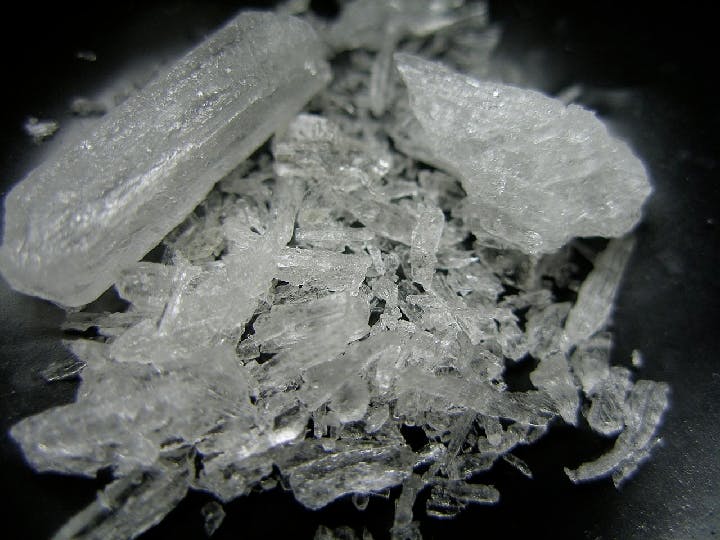Summer 2013
North Korea has a Meth Epidemic
– The Wilson Quarterly
Add “meth epidemic” to North Korea’s long list of ills.
If you live in North Korea, you shouldn’t be reading this. You get your news from a pre-set state radio installed in your home. Party propaganda serves to remind you: The state is always watching.
Or is it? North Koreans evince less concern about the police state than they used to. They flout the rules in all sorts of ways, such as tuning in to foreign news shows on shortwave radios and enjoying South Korean soap operas on pirated DVDs. They even have the temerity to try illicit drugs — and get hooked on them.
That’s right, defectors from the Hermit Kingdom say the country is caught up in a methamphetamine epidemic, report Andrei Lankov, a historian at Kookmin University in Seoul, and Seok-hyang Kim, a sociologist at Ewha Womans University, also in Seoul, in North Korean Review.
North Korea is no stranger to dope. For years, the state specialized in the export of illegal drugs. The communist regime in Pyongyang cultivated opium on plantations and churned out potent methamphetamines at government-run pharmaceutical plants. It was a quick, if unsavory, way to fill the Dear Leader’s coffers.
But in the early 2000s, for reasons unknown, Pyongyang sharply curtailed drug production. Scientists and technicians who had fueled the operation lost their jobs. “Private entrepreneurs began to look for such people and give them money” to manufacture drugs, a North Korean defector recounts.
From being virtually unheard of before 2004 or 2005, methamphetamine use among North Koreans suddenly caught on in the regions around the shuttered pharmaceutical plants. According to interviews with 21 North Korean defectors, the drug hasn’t stopped spreading since. “It seems that the epidemic has reached remarkable proportions and keeps growing, engulfing new social groups and new regions,” Lankov and Kim write.
The authors say the meth craze followed the pattern set by drug epidemics elsewhere. First, a conspicuous elite glamorizes use of the drug. Then the masses scramble to get in on the action.
In North Korea, Communist Party officials were the first to dabble in the highly addictive synthetic stimulant. “Police officers, state security officers, party cadres, administrative officials, they all had their [supply] lines, and they spread it among their friends,” a defector remembers.
State bigwigs excused their habits by claiming that they needed an extra pick-me-up to cope with stress and long hours at work. Officials seduced women by flaunting their ability to get their hands on the drug. Some high-end restaurants even offered methamphetamine as postprandial fare, “as if it were a dessert or a cup of coffee,” Lankov and Kim marvel. North Koreans reported that the drug offered all sorts of health benefits, such as curing back pain and resuscitating stroke victims. Following Western drug slang, they called the miracle powder orum (“ice” in Korean) or pingdu, a Korean rendering of the Chinese word for ice.
Thanks to the rave reviews, meth use soon percolated from apparatchiks to others. One defector who had been a construction worker in North Korea recalls that “some 70 percent” of his male coworkers in their twenties used the drug. Other interviewees, most of whom hail from the province of North Hamgyong, which borders China, speak of “extremely wide use of methamphetamine, often claiming that — at least in the borderland areas — the majority of younger North Koreans have sampled the drug,” Lankov and Kim report, though they think that these estimates, while indicative, are exaggerated.
North Koreans produce ice by processing ephedrine — just as their counterparts in the United States do. Manufacturers set up labs in idle factories, of which there are many, and other out-of-the-way places. The ephedrine is smuggled from China, courtesy of Chinese gangs. Formerly, the drug was often smuggled back into China and sometimes made its way to South Korea, but now most of it is consumed domestically.
The epidemic coincides with the withering of a North Korean government beset by corruption and criminality. The all-seeing surveillance state isn’t what it used to be; its drug policies are “inept and inactive.” Enterprising North Koreans run “booming if unofficial private manufacturing and commerce” operations. While foreign trade companies are ostensibly owned by the state, Lankov and Kim say that their fat-cat executives are the “de facto owners.” The same is true of restaurants.
As for the drug itself, the honeymoon is over. North Koreans use the word munlan to describe the ravaged state that comes of long-term methamphetamine abuse. Those who fled before 2008 have never even heard the term.
Pyongyang has apparently tried to crack down on meth dealers by slapping them with two-year prison sentences. In a land where dissidents end up in the gulag, that’s hardly a stiff penalty.
Lankov and Kim paint a dark picture of the North Korean future. In addition to widespread malnutrition and “the disintegration of the public health system,” the country now faces a drug epidemic that “will further aggravate the already horrendous situation” in the next few years.
THE SOURCE: “A New Face of North Korean Drug Use” by Andrei Lankov and Seok-hyang Kim. North Korean Review, Spring 2013.
Photo courtesy of Wikipedia
